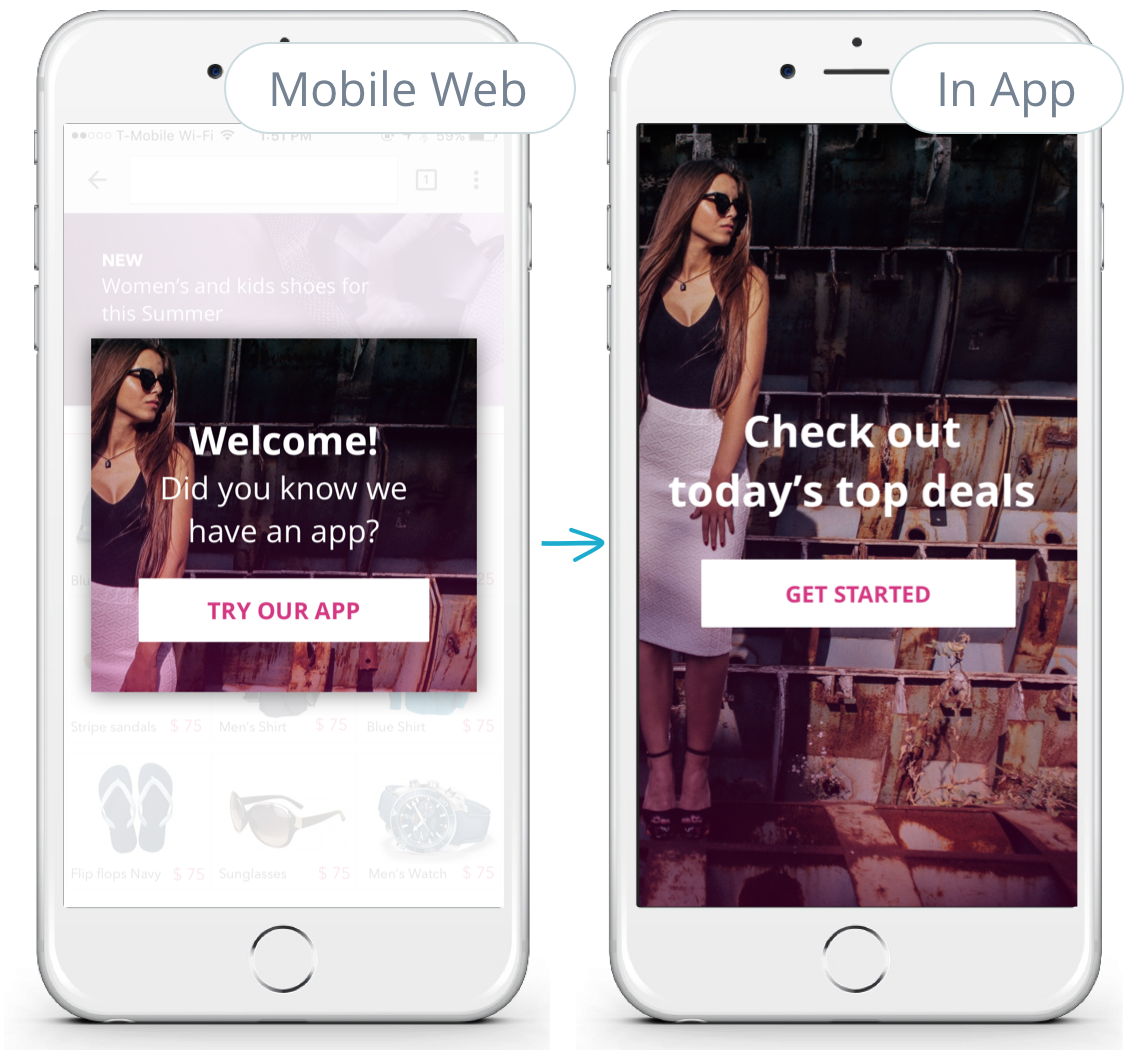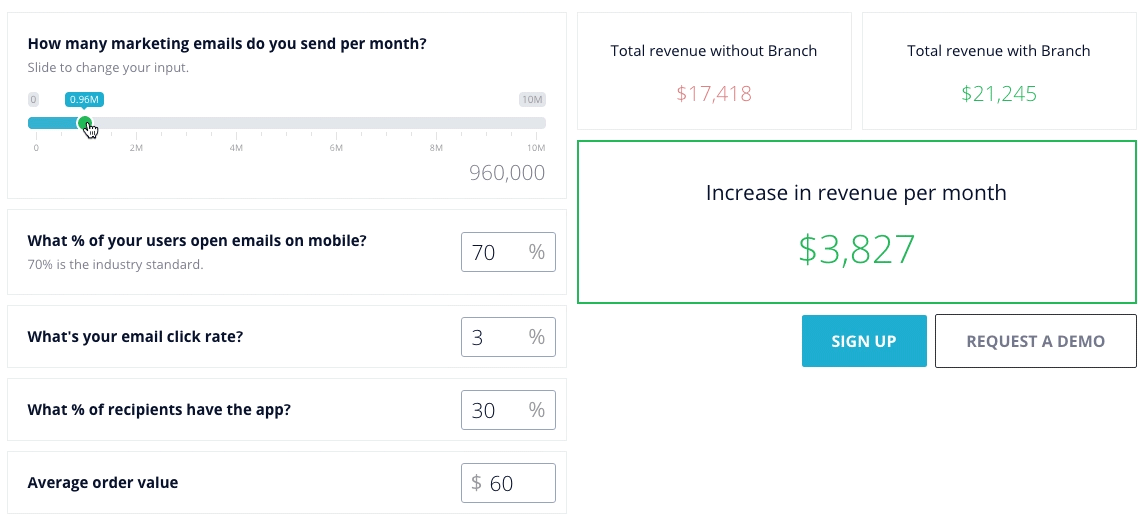This blog post was originally published in 2016. You can also read recent insights on web-to-app conversions.
Here at Branch, we’ve talked a lot about the current mobile ecosystem and the value of app users. For instance, on Black Friday, 41% of purchases came from a mobile device. But capturing a slice of this engagement continues to prove difficult. Why is that? Well, there are a lot of reasons. Apps are competing to stand out in an extremely saturated market and converting fickle millennials into engaged app users is an uphill battle. Yet, despite this disconcerting knowledge, businesses must build and market apps to stay relevant in our increasingly mobile world.
Increasing App Conversions and Purchases
eCommerce companies have likely benefited most from the growth of mobile apps. Compared to mobile websites, apps not only consume more of a user’s time, they lead to a 286% increase in products viewed, 23% increase in purchases, and an increase of 120% in conversion from view to purchase. There are certain tactics eCommerce mobile marketers can use to increase app downloads, but as we’ve seen time and time again, this isn’t the ultimate measure of success. These are businesses, and businesses need to drive purchases and revenue. The following tips focus on eCommerce companies, but can be translated easily to apps of all industries.
Convert Web Visits to App Users
Not too long ago, most eCommerce companies focused solely on their web presence. Mobile apps were a mere afterthought because mobile users could access their same beloved desktop websites just as easily on mobile web. Fast forward to today and that theory no longer holds. The mobile web experience has proven to be broken, evidenced by abysmal mobile web engagement. Those same companies that didn’t foresee the shift in the mobile landscape toward apps have clamored to enter the app market late and are struggling to gain the same traction they experienced on desktop web.
Do not fear, because app success isn’t impossible. If you do have a solid web presence, the best way to grow and increase app transactions is to take advantage of the web traffic that you’re already generating. Since a majority of searches now occur on mobile, chances are there are thousands of people landing on your mobile website. Instead of keeping them there for a clunky checkout experience, transition them to your app. Journeys, our web to app tool, allows you to create custom assets on your mobile website, such as smart banners or interstitials, which deep link users to the same page they were viewing on web, in the mobile app. By using this method, Jet saw a 3x increase in average daily downloads.
Drive Engagement Across Multiple Marketing Channels
Mobile marketing is far from one-dimensional. In order to stand out and drive bottom line success, apps must run successful marketing campaigns across a variety of channels. These channels may include paid acquisition, content sharing, email marketing, and much more. These channels vary in terms of their maturity, expected success, and ROI, yet they have one thing in common: they are all improved with deep linking.
Deep linking continues to improve important app metrics across all channels, including conversion to purchase and retention by over 2x. And since we’re focusing on increasing in-app purchases, let’s look specifically at a channel where deep links significantly improve a company’s bottom line.
Deep Linking from Marketing Emails
Out of the potential app marketing channels, email marketing is the most mature. For years, eCommerce companies have relied on email marketing to drive re-engagement and revenue. However, in recent years, more and more users are opening emails on mobile (nearly 70%, in some cases), where the traditional user flow is hindered by mobile web. Noticing this trend, crafty marketers started inserting deep links into their marketing emails to optimally route users to the ideal user experience.
But from the marketer’s point of view, the process of adding Branch deep links to email was slow and hard to scale. That’s why we’ve now partnered with multiple Email Service Providers to bring you Universal Email, allowing you to automatically turn your email links into deep links that route users to the appropriate location in your app.
How can you be sure this increases app purchases? While building this product, we worked closely with multiple top eCommerce brands to run the numbers to determine how much revenue deep linking emails can drive. Using the improved conversion rate, increase in spending from app users, and a number of other factors, we developed an email revenue calculator to help you determine how much revenue you’re leaving on the table. JackThreads saw a 21% increase in revenue per email as one of the first companies to test deep linking from email.
Experiment to See What Works for You
Email is just one of the marketing channels today’s mobile marketers can utilize to help promote their app and drive purchases. Below is a list of a few other marketing channels and the associated benefits that mobile marketers have seen by utilizing deep linking. By testing out multiple channels, marketers will be able to determine which is most effective for them.
- App discovery: Since over 50% of searches happen on mobile, deep links can be used to index app content for Google’s Firebase App Indexing and Apple Spotlight.
- Paid search: Apps can use deep links to reduce cost per install by 16% by advertising content rather than the app itself.
- Social: Companies can increase app engagement by 2x by promoting timely, relevant app content.
- Referrals: By creating incentivized referrals, apps generate a 31% increase in conversion to sign up.
- App to app: By building an app to app experience with Instacart, Yummly saw a 35% increase in one-week retention for shopping users.
- Content sharing: By allowing users to deep link friends to app content, some apps are seeing a 7x increase in number of links shared.
Additional Strategies for App Purchases
In Q4 of 2015, 54% of mobile transactions occurred in apps, versus 46% on mobile browsers. Mobile is here to stay and will only continue to grow. This is just the tip of the iceberg when it comes to strategies for sustaining app growth and increasing revenue. If you’re interested in more tips, check out the 2016 Mobile Growth Handbook for industry insights, must-read blogs, and statistics on the mobile industry.

























